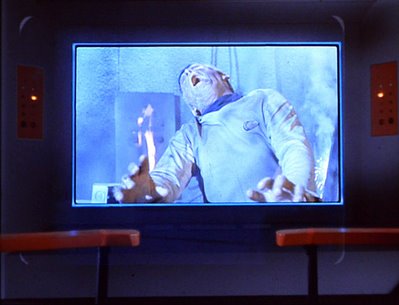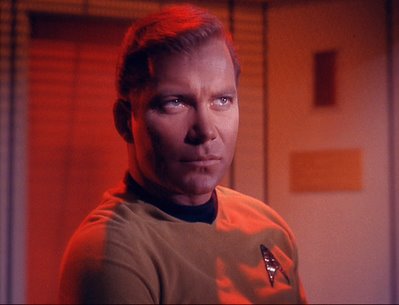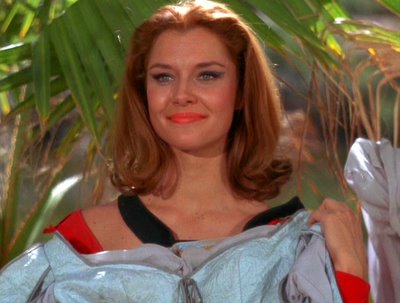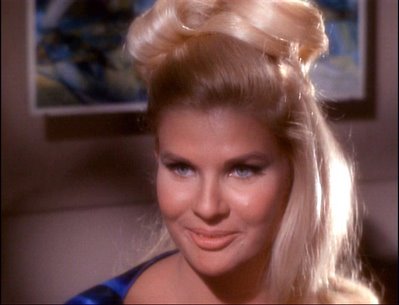Captain's Log: 11030.6.
The second episode in what would have been last week's leg of The Trektastic Voyage is one I'm almost afraid to write about, the classic "Balance of Terror." I say I'm almost afraid to write about it because from the performances to the set lighting to the camera work, this film is a symphony of drama and tension. Every aspect of the episode's production hits all the right notes, making "Balance of Terror" one of the top three episodes in the history of Trek, along with "City on the Edge of Forever" and "Space Seed."
"Balance of Terror" begins with a joyful occasion: the wedding of two crewmembers. Kirk begins the ceremony when Spock calls for Kirk, informing him that the Earth outposts (which we'd later know to be called Starbases) the Enterprise was heading for have winked out of contact. Kirk sounds red alert and the crew snaps to attention, leaving Angela Martine and Robert Tomlinson standing at the altar. They exchange worried glances and then head to their duty stations as well, and we follow Kirk as he strides determinedly towards the bridge.
So begins one of the most tense episodes of any Trek series to date. The episode is so well-paced, we don't have to wait to find out what's up. The Enterprise crew witnesses the destruction of the last Earth outpost by what is clearly a Romulan vessel. In a scene that builds the crescendo of the episode's action, we learn from Spock's address to the crew that the Romulans and Earth and her allies were engaged in a bloody war two hundred years earlier. The state of technology at the time made visual communication impossible, and thus no one has ever seen a Romulan.
Shortly thereafter, Spock is able to intercept the Romulan ship's transmissions, and in a powerful scene which switches from the Romulan on the screen to Kirk and Spock and then back to Kirk and Stiles, showing their reactions, a Starfleet crew gets its first glimpse of a Romulan: the ship's commander, played by the talented Mark Lenard, who would go on to play Spock's father Sarek for many years afterwards. The huge revelation here is that the Romulans look almost exactly like the Vulcans, which leads to a great deal of unease for Spock. After Spock presents his analysis of the debris leftover from one of the outposts, Kirk decides the Enterprise must pursue the Romulan vessel and prevent it from reaching the Neutral Zone, a space established after the Earth-Romulan War that is off limits to both parties.
After a tense game of cat and mouse that damages both ships, Kirk finally gains the upper hand and has the Romulan commander and his ship at Kirk's mercy. Kirk signals for the Romulans to surrender and prepare to be boarded, but the Romulan commander refuses, and expresses his sorrow that he and Kirk did not know each other in a differnt context, for they might have been friends. The Romulan commander activates his ship's self-destruct, and the ship is vaporized before the eyes of the bridge crew. We also learn that the only fatality from the encounter with the Romulans was Tomlinson, and the episode closes with Kirk comforting Martine over the loss of her fiance.
"Balance of Terror" is one of the truest examples of what Star Trek is and what it's about. If someone asked me to show them an episode that would hook them on the show, this would be it. From Kirk's resolute determination and tactical brilliance, to the prejudice Spock experiences from Stiles, this episode shows us a very bold future, peopled with characters who remain human despite the advancements of the future. Unlike what became of Star Trek The Next Generation, The Original Series characters are real and human, and this episode gives us the tension and frailty that makes this show so resonant even forty years later. We feel terror as we watch Commander Hansen of the outpost die, we feel Kirk's hopelessness as he struggles with whether or not he should pursue the Romulans and possibly start a costly war, we identify with Stiles's fears about the Romulan threat, and we sympathize with Spock, misunderstood and feared because of his link to the Romulans. All in all, "Balance of Terror" does what good Trek always did: it makes us confront our own convictions and indeed our very selves and consider what it means to be human.
Screencaps from "Balance of Terror."
The episode's title card.

Kirk enjoying a rare pleasant duty: the marrying of two members of his crew.

Cdr. Hansen's violent death at the hands of the Romulans.

The first appearance of a Romulan in Star Trek, played by Mark "Sarek" Lenard.

In a gripping scene, Kirk and Stiles react to seeing the Romulan's resemblance to Vulcans.

Spock as he takes in the view of his Romulan cousin on the viewscreen.

Captain Kirk, determined to stop the Romulans from returning home at any cost.

Kirk walks the corridors of his ship after consoling Martine, perhaps realizing that he and his ship could have very easily suffered the fate of the his Romulan counterpart.



































